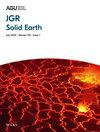高密度地震和大地电磁资料揭示的2021年陆仙MS6.0诱发地震地壳特征对比
IF 4.1
2区 地球科学
Q1 GEOCHEMISTRY & GEOPHYSICS
引用次数: 0
摘要
2021年的芦仙地震引发了人们对四川盆地南部地震潜力的担忧,并强调了进一步了解该地区地震风险的必要性。为了阐明中国有记录以来最大的水力压裂诱发地震的潜在机制,本研究通过综合地震和大地电磁(MT)方法研究了这一重大事件的当地孕震环境。利用基于线性Radon变换的模式分离方法,我们从密集的地震数据中导出了三维精细分辨率的速度结构。利用同位MT阵列的电阻率测量数据,我们的综合数据集为华蓥山断层(HYS - F)复杂的上地壳地质构造提供了令人信服的证据。除了HYS - F内3-4 km深度的低速和电阻率带外,与流体注入点的位置一致,我们在主震下方超过15 km深度的地方新发现了一个大规模的低电阻率异常。在HYS‐F的东南部出现了类似的结构模式,在那里,最近探测到的地震(包括地震和地震)的分布和震源机制突出了浅层流体注入和深层变质盐流体上升的综合影响,为地震活动创造了滋生条件。在西北方向有一个明显的高速高电阻率异常,从地表延伸到深度超过20公里,可能与来自下地壳的侵入古物质有关。研究结果表明,复杂的地质构造和动力过程强烈地影响着陆县震区地震的发生和分布。本文章由计算机程序翻译,如有差异,请以英文原文为准。
Contrasting Crustal Signatures Across the 2021 MS6.0 Luxian (China) Induced Earthquake Revealed by Dense Seismic and Magnetotelluric Data
The 2021 Luxian earthquake has raised concerns about the seismic potential in the southern Sichuan Basin and highlighted the need to gain a further understanding of the area's seismic risks. To elucidate the underlying mechanisms driving the largest recorded hydraulic fracturing‐induced earthquake in China, this study investigates the local seismogenic environment of this notable event through an integrated seismic and magnetotelluric (MT) approach. Utilizing a linear Radon transform‐based mode‐separation method, we derived a 3‐D fine‐resolution velocity structure from dense seismic data. Corroborated by resistivity measurements using a co‐located MT array, our integrated data set provides compelling evidence for a complex upper‐crustal geological structure across the Huayingshan fault (HYS‐F). Apart from the low velocity and resistivity zones at 3–4 km depth within the HYS‐F, consistent with the location of fluid injection sites, we newly discovered a large‐scale low‐resistivity anomaly beneath the mainshock at depths exceeding 15 km. A comparable structural pattern emerges in the southeast of the HYS‐F, where the distribution and focal mechanisms of recently detected earthquakes, including and earthquakes, highlight the combined influence of shallow fluid injection and the ascent of deep metamorphic saline fluids in creating a breeding condition for seismicity. A prominent high‐velocity and high‐resistivity anomaly in the northwest, extending from the surface to depths exceeding 20 km, is potentially linked to intruded ancient materials originating from the lower crust. Our findings reveal that complex geological structures and dynamic processes strongly impact the occurrence and distribution of earthquakes in the Luxian earthquake region.
求助全文
通过发布文献求助,成功后即可免费获取论文全文。
去求助
来源期刊

Journal of Geophysical Research: Solid Earth
Earth and Planetary Sciences-Geophysics
CiteScore
7.50
自引率
15.40%
发文量
559
期刊介绍:
The Journal of Geophysical Research: Solid Earth serves as the premier publication for the breadth of solid Earth geophysics including (in alphabetical order): electromagnetic methods; exploration geophysics; geodesy and gravity; geodynamics, rheology, and plate kinematics; geomagnetism and paleomagnetism; hydrogeophysics; Instruments, techniques, and models; solid Earth interactions with the cryosphere, atmosphere, oceans, and climate; marine geology and geophysics; natural and anthropogenic hazards; near surface geophysics; petrology, geochemistry, and mineralogy; planet Earth physics and chemistry; rock mechanics and deformation; seismology; tectonophysics; and volcanology.
JGR: Solid Earth has long distinguished itself as the venue for publication of Research Articles backed solidly by data and as well as presenting theoretical and numerical developments with broad applications. Research Articles published in JGR: Solid Earth have had long-term impacts in their fields.
JGR: Solid Earth provides a venue for special issues and special themes based on conferences, workshops, and community initiatives. JGR: Solid Earth also publishes Commentaries on research and emerging trends in the field; these are commissioned by the editors, and suggestion are welcome.
 求助内容:
求助内容: 应助结果提醒方式:
应助结果提醒方式:


